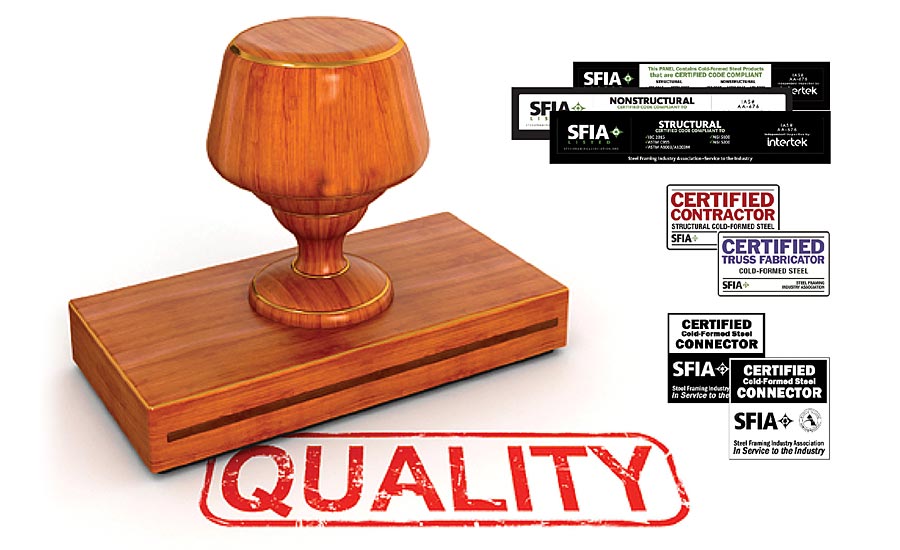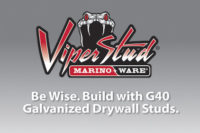Last month, I urged specialty contractors to watch out for conflicts between project specifications and building code requirements, especially where the 2018 edition of the International Building Code has been adopted. The primary reason is the shift from referencing ASTM standards to AISI standards for cold-formed steel. Out-of-date architectural specifications that don’t synch up with the prevailing building code can cause delays, result in change orders and ultimately create liabilities that could undermine the success of the project.
This month, I write about quality control in your work as a contractor and in product selection. As cold-formed steel construction projects have become larger and more complex, quality assurance has increasingly become part of a contractor’s standard operating procedures and project requirements.
Now with the transition to AISI standards in the 2018 IBC comes a near certainty that if you haven’t been seeing quality assurance/quality control requirements in project specifications you will soon. That’s because AISI standard S240 “North American Standard for Cold-Formed Steel Structural Framing” has an added chapter that establishes the minimum QA/QC requirements for material control and installation.
Two Ways AISI Impacts Contractors
Specifications with new or expanded QA sections typically require the contractor to provide “documentation on the qualifications of the contractor that will install the cold-formed steel framing.” There are a variety of ways to respond to this requirement, but one particularly effective approach is to become an SFIA Certified Contractor.
Similar to certification programs for other trades, SFIA Certified Contractor applicants must demonstrate knowledge of codes, standards, and applicable tolerances associated with cold-formed steel framing. Technical ability is verified through the inspection of installations by a licensed professional engineer. An additional certification is available for truss fabricators who can demonstrate the knowledge and proficiency to meet the code requirements.
Product selection is the second area where AISI requirements could affect the contractor. Even before QA/QC became an important consideration, contractors choosing among cold-formed steel products had a difficult job. Literature comparisons, statements of code compliance, data about physical properties, limiting heights tables vary substantially from one manufacturer to the other. This lack of certainty is a cause for unease among contractors facing scrutiny from building inspectors and an environment where product liability lawsuits have significantly increased over the last decade.
QA provisions in the project specifications raise the stakes by requiring verification that the cold-formed steel products used comply with project requirements and the minimum requirements identified in the prevailing codes and standards. This underscores the importance of certification programs.
QA/QC for Products
To the casual observer, QA and QC may not seem like much of a distinction. But it is.
A QA product certification program is process/document based and reviews plans for all relevant manufacturing processes, including training, sales, raw material ordering, fabrication, packaging, and every other step to ensure the customer gets what he’s paying for.
A QC product certification program is QA plus physical product testing. Physical testing is the only valid certification process that confirms the product performs as intended.
For the contractor trying to select a product, a QA certification ensures that correct processes are in place, providing a high level of certainty that the products are being produced consistently, and with the same characteristics, as the sample tested under QC.
The SFIA has two QA product certifications:
The SFIA Code Compliance Certification Program for Cold-Formed Steel Stud and Track requires the manufacturer to have a documented QA program that defines the controls and procedures used during the manufacturing to ensure the correct steel is ordered. Checks during the manufacturing process allow production crews to monitor tolerances and stud shapes as the framing material comes off the line. Record-keeping requirements provide a variety of benefits, including the ability to better identify breakdowns in the processes that may have resulted in product failures. Intertek, an independent third-party verifier, ensures the program’s integrity by making unannounced visits to member plants to audit procedures and test samples.
The SFIA Connector Manufacturing Compliance Certification Program is similar to the Stud and Track Certification program in that it requires that a QA program be in place. It certifies the coating weights and mechanical property requirements and ensures that the manufactured connector matches the design or part drawings. This extra step helps assure architects, owners, and building officials that the cold-formed framing connectors specified and installed meet recognized standards and manufacturer specifications. (This program is also administered by Intertek.)
The emphasis on QA/QC in the construction industry is not likely to abate as long as the design and construction of buildings continue to become more and more complex. And, the addition of QA/QC in AISI Standards and project specifications means that contractors will need to be ready to credibly prove their expertise and ensure that the products they’re buying and installing meet the project requirements.






Report Abusive Comment